Crete Senesi - Val d'Orcia
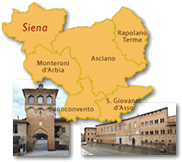
A characteristic typical of the Sienese territory consists in the presence of a widespread network of fortified farms (granges) which, long ago, orbited around the Santa Maria della Scala Hospital of Siena. Mainly located along the Via Francigena on the sites of hospices for pilgrims in the Middle Ages, the granges served to stock the grain necessary to support the hospital activity.
The splendid complex of Santa Maria della Scala, recently restored and returned to the public, offers tourists visiting Siena a rich series of museum itineraries where history, art and science come together to form a fascinating unicum.
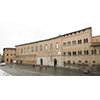
The very ancient hospital, founded by the Cathedral Canons to shelter pilgrims, assist the poor and take in abandoned children, was mentioned already in a document from 1090. It was called "della Scala" because of its position, directly facing the stairs leading up to the Cathedral’s entrance. The hospital’s relief activities and its daily life are admirably illustrated in the so-called "Pilgrimage" cycle of frescoes painted between 1441 and 1444 by Domenico di Bartolo, Lorenzo Vecchietta, Priamo della Quercia (brother of Jacopo) and Pietro di Giovanni d'Ambrosio, commissioned by the Rector of the Hospital Giovanni Buzzichelli. The architectural style of the Pilgrimage, a great structure where pilgrims were accommodated, is clearly derived from France, bearing witness to the continuous contacts between Siena and Europe made possible by the Via Francigena. This enormous thoroughfare, which is still visible and can still be traversed in part, connected Italy to Northern Europe, and was travelled each year by thousands of pilgrims journeying to the great sanctuaries (St. Peter’s, St. James of Compostella, and Montauban). For this reason it was highly important for the founding and development of the numerous hospitals that, from the 11th century on, replaced the so-called "Xenodochi" (from the Greek xenos = foreigner, and dokeion = hostel). Travellers in the Middle Ages, often preyed on by bandits and exposed to the continuous danger of contracting contagious diseases, found in these hospitals not only a bed for the night but also nurses, stables for their horses and warehouses in which to deposit their goods.
The Hospital of Santa Maria della Scala, thanks to generous alms and to the legacies of pilgrims, soon became autonomous enough on the economic level to allow the development of an organisation independent of religious power, regulated by an innovative statute dating from the early 14th century. Its management became progressively more secular up to 1404, the year in which the Commune claimed for itself the right to elect the Rector, the institution's highest authority. Moreover, the enormous farmlands owned by the Hospital, the "granges", provided a source of subsistence for the city in times of famine or epidemic.
In 1411 a pharmacy was established, and in the 16th century it was enriched by an important group of ceramics, mainly of local production. In 1518 it possessed around 1,800 vases, only scarce testimony of which remains on display in the hospital today. In 1588 a "Giardino dei Semplici", or medicinal herb garden, was annexed to the hospital.
Always active over the centuries, the hospital employed an anatomical dissector (1743), masters of surgery, masters of childbirth and of anatomy (1759). It also formulated rules for the training of practising doctors and student interns, arranged for consulting university professors in difficult cases, improved assistance to the mentally ill and to women giving birth. In 1778 the university and the hospital shared on an equal basis the costs of improving the equipment of the anatomical cabinet. In the 18th century the work of Paolo Mascagni, professor of anatomy at the university, was outstanding. In the early years of the 19th century it became compulsory for newly graduated students to spend a period of practical training at the hospital, consisting of two years for physicians and five years for surgeons.
Today the ancient Hospital of Santa Maria della Scala is a large and fascinating museum complex possessing important Sienese collections on the history of art and the history of medicine.
(Antonella Gozzoli)
Among the most significant testimonies of the farms that gravitated around the Hospital, one particularly worthy of mention is the Serre Grange, headquarters of a museum that illustrates the history and development of these unique fortified structures. To get there, leaving Siena, take SS408 up to the junction with the SS438 road which you take for about 30 km.
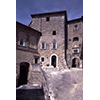
The grange was a fortified farm that grew up in the place where, in medieval times, a hospice offered lodging to travellers following the Via Francigena. Situated in the Sienese countryside, in the midst of the vast estates owned by the Hospital of Santa Maria della Scala in Siena, it was a centre for the storage of grain and all of the agricultural production necessary for the hospital's activity. Its fortification, which served to safeguard the stores from incursions, represents an interesting architectural type. Today the most important granges are those of Monteroni, of Montisi and of Serre. In the latter, in 2001, the Museum of the Grange was inaugurated, divided into two sections, the Olive Oil Museum and the Grange Documentation Centre. The first of these museums, housed in an ancient olive-mill, displays a collection of implements and materials from the 20th century pertinent to olive-growing and the production of olive oil. The Grange Documentation Centre illustrates, instead, the development of these singular fortified centres. Four multimedia stations, in particular, offer a virtual tour of the building, while tracing its history within the system orbiting around the Hospital of Santa Maria della Scala. Today the Museum forms part of the Sienese Museum System.
(Stefania Mangia)
Proceeding past the Serre Grange, you come to the Cuna Grange, perhaps the best preserved example of the granges on Sienese territory. It can be reached continuing 25 kilometres onward past the former on SP26 and SP12.
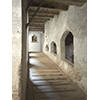
The Cuna Grange is one of the best preserved medieval fortified farms, interesting also from the architectural viewpoint. It stands where, already in the 12th century, there existed a "Spedale" that lodged and assisted pilgrims and merchants travelling along the Via Francigena. In the 13th century it became the property of the powerful Hospital of Santa Maria della Scala in Siena, and the building underwent numerous enlargement and remodelling initiatives. In 1314 the new granary was built and the church dedicated to the Santi Giacomo e Cristoforo was remodelled; today it stands just outside the circle of outer walls. The granary was fortified to safeguard the stores of grain and other cereals.
Other famous buildings with similar functions are the Serre Grange at Rapolano, now the site of a Museum, and the Montisi Grange, privately owned. The complex, perfectly preserved, is composed of a small village, the fortified farm and the church. Over the centuries, popes and kings have stayed here, from Urban VI, in 1386, to Martin V, to Paul III. Charles of Lorraine died here in 1640.
(Mara Miniati)
Only 2 kilometres from the Serre Grange, the impressive fortified Mill of Monteroni d’Arbia, is a structure dating to the first half of the 14th century, which documents attest as property of the nearby grange.
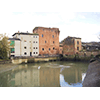
The town of Monteroni d’Arbia is home to a beautiful fortified watermill, dating to the first half of the 14th century. The impressive building appears among the properties of the nearby Cuna grange, as testified by several documents of the 16th century, including one dated 1590 that bears the estimate of the rent due for a sum of 8 liras. From this and another previous document (1552), we know that the Mill worked with two millstones, though it possessed four, probably because of a decrease in flow of the waters that supplied the millrace. The fascinating hydraulic system with its round-arch conduits permitted the water to arrive inside the mill to produce hydraulic energy, and then return outside with its chemical-physical properties unchanged. Recent studies have shown that in its period of greatest activity, the Mill could produce up to half a ton of flour per day.
(Elena Fani)
To complete your visit, you can take SR2 past San Quirico d’Orcia and then take SP53 where, immersed in the green Val d’Orcia, you will find the scenographic Spedaletto Castle.
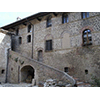
Built in the 12th century by the monk Ugolino da Rocchione, Spedaletto Castle was born to host the pilgrims and wayfarers who travelled the old Via Francigena, one of the most important roads in Europe in the Middle Ages. Like many other fortified structures in the province of Siena, the complex fell under the influence of the Spedale di Santa Maria della Scala as of the 13th century. The original square-plan structure with corner towers and projecting stone corbels, was fortified between the late 15th century and the early 16th century, with the addition of a slight escarpment and embrasures for the use of fire arms.
The splendidly preserved castle today houses an agritourism facility.
(Elena Fani)
****************************
Texts by Elena Fani
English translation by Victor Beard
Last update 11/gen/2008



 = libraries and archives
= libraries and archives  = scientific research centers
= scientific research centers  = memorial places of scientists
= memorial places of scientists = public health places
= public health places = places of science and worship
= places of science and worship = places of technology
= places of technology  = museums and collections
= museums and collections  = villas and gardens of science
= villas and gardens of science


